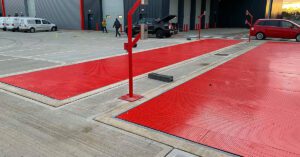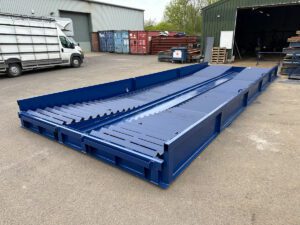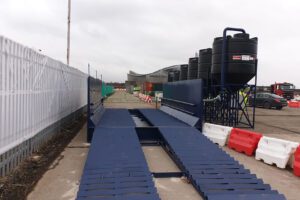Useful terms common in the weighing industry
We’ve compiled a handy list of weighing terminology used throughout our website and within different industries that we supply and support with our weighbridges and other industrial weighing scales.
Accuracy
in weighing systems refers to how close the measured weight of a load is to its true or actual weight. It is an important performance characteristic of weighing systems, as it impacts the reliability and consistency of the measurements. Accuracy is influenced by a variety of factors such as the quality of the load cells, the stability of the weighing platform, the calibration of the system, and the environment in which it operates. High accuracy is critical in many industries, such as pharmaceuticals, food and beverage, and chemical processing, where precise and consistent measurements are required to ensure product quality, safety, and regulatory compliance. In contrast, lower accuracy requirements may be acceptable in applications where precision is less critical, such as in bulk material handling or mining operations.
ANPR
ANPR stands for Automatic Number Plate Recognition. It is a technology that uses optical character recognition (OCR) to automatically read and capture the license plate numbers of vehicles. ANPR systems use cameras to capture images of passing vehicles and then analyze the images to extract the characters on the license plate. The captured information can then be used for various purposes, such as tracking vehicle movements, identifying stolen vehicles, or enforcing parking regulations. ANPR technology is used in a variety of applications, including law enforcement, toll collection, and parking management.
Axle weight
the weight of the vehicle supported by each individual axle.
Axle weigher
An axle weigher, also known as an axle scale, is a type of weighing system used to determine the weight of individual axles or groups of axles on vehicles. It consists of a platform or plates placed on the ground, the load cells measure the weight of the vehicle as it drives over the platform. Axle weighers can be portable or permanent installations, and may be used for various applications such as weighing trucks at weigh stations, monitoring load distribution, and checking compliance with weight limits on roads and bridges. Though software, single axle weighers can be used to determine the weight of the whole vehicle as each axle passes over the scale.
Batch weighing
A process that involves weighing a predetermined amount of material for a specific purpose, such as recipe formulation or inventory control.
Belt scale
A Belt scale or Belt weigher is weighing system that measures the weight of material moving on a conveyor belt. Usually sections of the conveyor belt frame is fitted with a load cell system. Belt weighers are common in mining operations as well agriculture, food processing, waste management and construction.
Bending Beam Load Cells
Bending beam load cells are used in applications where high accuracy and low capacity is required. They are commonly used in laboratory balances, medical devices, and low-capacity industrial scales.
Bogie weigher
A train weighing system used to measure the weight of each bogie (a frame carrying a pair of axles) of a train separately.
Calibration
the process of adjusting the weighbridge or any scale to ensure accurate and precise measurements.
Checkweigher
A system that checks the weight of a product against a pre-set target weight and rejects products that fall outside of the acceptable weight range.
Canister Load Cells
Canister load cells are heavy-duty load cells that are designed for use in harsh environments such as construction sites, mines, and offshore platforms. They are typically used in high-capacity applications such as weighbridges, silos, and tanks.
Compression Load Cells
Compression load cells are designed to measure compressive forces and are commonly used in industries such as automotive, aerospace, and construction. They are often used in testing and monitoring applications, such as measuring the force required to compress a spring or the pressure inside a container.
Double Shear Beam Load Cells
A double shear beam load cell is a type of load cell used for measuring force or weight in industrial weighing applications. The load cell consists of a metal body with two sets of parallel shear beams mounted inside, with the load applied to the center of the load cell. The double shear design provides a more stable and accurate measurement than a single shear beam load cell, as it reduces the effects of off-center loading and side forces. The load cell produces a signal proportional to the applied force or weight, which is then converted into a digital or analog output by a signal conditioner. Double shear beam load cells are commonly used in applications such as truck scales, platform scales, and tank weighing systems, where high accuracy and stability are required. They are also known for their durability and resistance to shock and vibration, making them suitable for use in harsh environments. All of Libra’s weighbridges are built with this type of load cell.
Donut Load Cells
Donut load cells are compact load cells that are ideal for applications where space is limited. They are commonly used in medical devices, robotics, and aerospace applications.
Dynamic weighing
weighing a moving vehicle as it passes over the weighbridge
Gross weight
the total weight of the vehicle, including its load
Hopper scale
A weighing system that measures the weight of material in a hopper or tank. Hopper scales are common in agriculture, used to weigh bulk materials such as grain or seeds.
Hydraulic Load Cells
Hydraulic load cells use hydraulic pressure to measure force and are commonly used in applications where high accuracy is required, such as in calibration systems, materials testing machines, and force measurement devices.
Indicator
a device that displays the weight reading from the load cell/s.
Legal-for-trade
A weighing system that meets the requirements of government regulations for commercial weighing applications.
Load Cell
A load cell is a transducer that converts force or weight into an electrical signal. View the different types of load cells we offer here.
Net weight
the weight of the vehicle’s load, calculated by subtracting the tare weight from the gross weight
OIML
The International Organization of Legal Metrology (OIML) weighing standards refer to a set of guidelines, recommendations, and technical documents developed by the OIML for weighing instruments and systems used in trade and commerce. These standards cover various aspects of weighing technology, including terminology, design, performance, testing, and verification. They are used by manufacturers, regulators, and end-users in a wide range of industries, such as food and beverage, pharmaceuticals, and logistics, among others. The OIML weighing standards are recognized and adopted by many national and regional metrology organizations around the world, and compliance with these standards is often required for legal metrology approvals and certifications.
Overload
when the weight of the vehicle exceeds the maximum legal limit for a particular road or bridge.
Overload protection
refers to a feature that prevents a weighing instrument from being damaged or inaccurately measuring weight when the weight applied exceeds the instrument’s maximum capacity. This protection can take different forms depending on the type of weighing instrument, but typically involves a sensor or mechanism that triggers an alert or error message to the user, indicating that the weight applied exceeds the instrument’s capacity. This helps prevent damage to the instrument or the surrounding environment, as well as ensuring accurate and reliable measurements.
Process weighing
is a term used to describe the measurement and control of material flow in a manufacturing or production process. It involves the use of weighing systems and sensors to monitor and measure the weight of materials as they move through various stages of production, from raw materials to finished products. The data gathered from process weighing systems can be used to ensure that materials are being used efficiently, to monitor product quality and consistency, and to identify opportunities for process improvements and cost savings. Process weighing is used in a wide range of industries, including food and beverage, pharmaceuticals, chemicals, and agriculture, among others.
Pneumatic Load Cells
Pneumatic load cells use air pressure to measure force and are commonly used in applications where the load cell must be isolated from the environment, such as in clean rooms or hazardous areas.
Remote display
a remote display unit shows the weight reading to the driver or weighbridge operator from a distance, remote from the weight indicator.
RFID
Radio Frequency Identification system that records the vehicle identification data for accurate identification of vehicles, these are common in unmanned weighbridge access control.
Shear Beam Load Cells
Shear beam load cells are commonly used in platform scales, conveyor belts, and packing machines. They are designed to measure both tension and compression forces and are ideal for applications where accuracy is critical. Also see Double Shear Beam Load Cells.
S-Type Load Cells
S-type load cells are commonly used in tension and compression applications, such as material testing machines, automotive test rigs, and wire rope tension systems. They are compact, easy to install, and offer high accuracy and repeatability.
Static weighing
weighing a stationary vehicle on the weighbridge.
Strain Gauge
A sensor that measures the deformation of a material due to an applied force or weight, typically used in train weighing applications.
Tare Weight
the weight of the empty vehicle or trailer, which is subtracted from the gross weight to determine the net weight
Train Balancing
The process of distributing weight evenly across a train to ensure safe and efficient operation.
Weighbridge
A weighbridge is a large type of platform scale used to weigh vehicles and their contents.
Weighing platform
the part of the weighbridge on which the vehicle is driven on to be weighed.
Weighing software
computer programs that interface with the weighbridge to collect, store, and analyze the weight data.
WIM
WIM in train weighing stands for Weigh In Motion. It is a technology used to weigh moving trains without the need for them to stop. WIM systems are typically installed on railway tracks and use sensors to measure the weight of passing trains as they travel at normal speeds. The sensors can be installed either in the rails or in the ballast beneath the rails. The data collected by the WIM system can be used to ensure that trains are not overloaded and to monitor the weight distribution of the load across the train. This information is important for safety and efficiency, as overloaded or improperly loaded trains can cause damage to the track or lead to accidents. WIM systems can also be used to collect data on train speeds and axle weights for operational and planning purposes.
Get in touch with us today
The ultimate aim for Libra is complete customer satisfaction, be it supply of one of the best weigh bridges available, to after sales service and on-going support. We aim to full fill all our obligations and more. Our helpful team is always available, 24/7, with instant response to assist.
We have an extensive network of highly skilled technicians ready to carry out all of our works throughout the UK, Europe and Internationally. We look forward to being of assistance, contact us anytime.
Latest News

Are you in the market for a weighbridge to optimize your business operations? We understand that selecting the right weighbridge is a significant decision that can impact your efficiency, accuracy, and overall bottom line.

Our customer had an old weighbridge that had been out of commission for some time and had definitely seen better days.

New 10m Drive Through Bath ready for delivery to a new Bloor Homes housing estate project near Portsmouth.

New Wheel Wash installed for large land reclamation project in London. Our client chose our Eurowash Advanced Plus system for their busy site.
